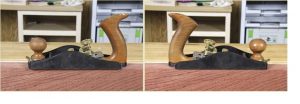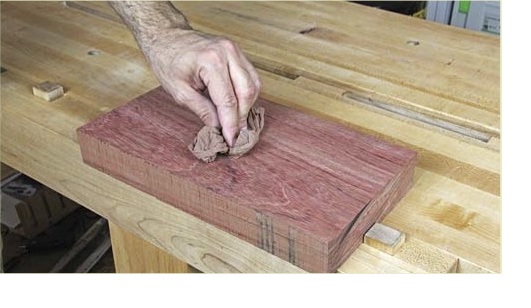We may receive a commission when you use our affiliate links. However, this does not impact our recommendations.
Today’s tip on how to read grain direction comes from none other than the Wood Whisperer, Marc Spagnuolo. It is just one of many tips and techniques in his brand-new 190-page book, “Hybrid Woodworking.” What a great read. Buy your copy today!
–Dan Farnbach
Grain Direction
by Marc Spagnuolo
Every board has grain direction and it’s a natural feature of wood that woodworkers need to become intimately familiar with. A good analogy for grain direction is the fur on my black Lab’s back. If I pet him from head to tail, my hand passes smoothly along his fur with no friction. But if I pet him from tail to head, my hand will catch in the hair making for a rougher feeling. While my dog seems to enjoy the attention either way, one direction is clearly against the grain. It’s the same for wood. Run a plane with the grain and you will experience a smooth cut, free of tear-out. Run it against the grain, and you’ll deal with excessive plane chatter and tear-out.

To judge the grain direction on the edge, look at the face. The plane in the picture on the left is going against the grain while the plane on the right is going with the grain.
As woodworkers, it’s important for us to learn how to read the grain. Fortunately, this is easy to do on most boards. If you want to know the grain direction on the face of a board, simply look at the side grain. If you want to know the grain direction of the edge of a board, take a look at the face. This methodology is important not just with handplanes, but also power tools.
Because grain lines aren’t always as evident as we’d like, some boards show little to no visual indicators of grain direction. In these situations, I employ the pantyhose trick. Simply bunch the hose up into a ball and run it across the surface of the board in both directions. You should notice that in one direction the material slides freely (with the grain), but in the other direction it catches on seemingly invisible fibers (against the grain). It’s a pretty cool trick for when all other methods fail.
Here are some supplies and tools we find essential in our everyday work around the shop. We may receive a commission from sales referred by our links; however, we have carefully selected these products for their usefulness and quality.










I use my grandmother’s old knee highs. She switched to ankle highs so she didn’t need the other one anymore.
Cheese cloth works the same and you won’t get that funny look from the cashier when you ask where it is at.
Do women still wear pantyhose??
Great idea….thxs!